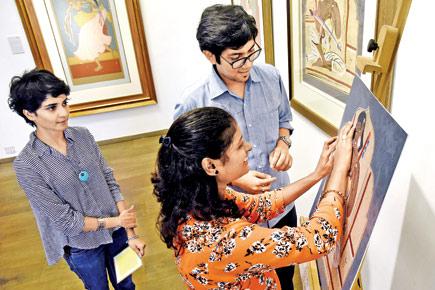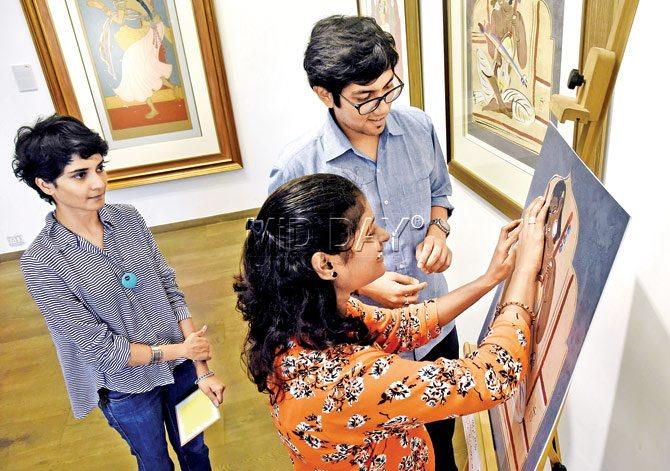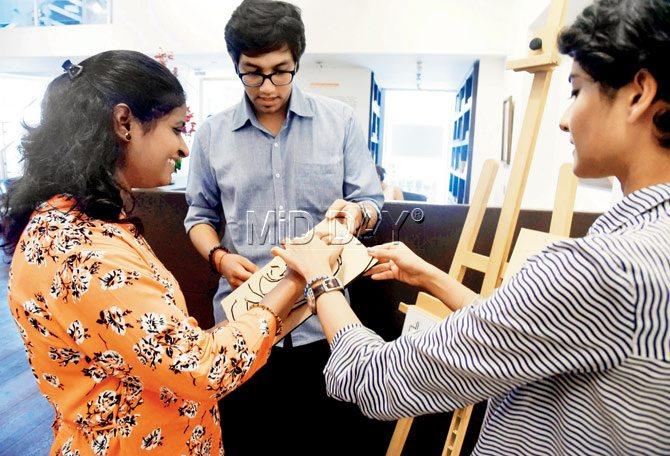mid-day takes a visually challenged clerk to experience a first-of-its-kind show in Kala Ghoda where works of masters are interpreted by tactile reproductions

Kaveri Acharya, Siddhant Shah and Radha Bakle discuss the tactile reproduction of a tempura on paper work by Nandalal Bose
![]() En route to the gallery, Radha Shamrao Bakle tells us of her lone experience with art. In a craft class at primary section at Dadar’s Smt Kamala Bai School for the Blind, teachers would place a thread in the shape of an apple on paper. "They told us what colours to fill the shape with — red for the fruit, and green for the leaf. I had partial sight then, so, though I have lost my sight completely now, I know that sky blue is my favourite colour," says Bakle, a 27-year-old clerk who works at a nationalised bank in Worli.
En route to the gallery, Radha Shamrao Bakle tells us of her lone experience with art. In a craft class at primary section at Dadar’s Smt Kamala Bai School for the Blind, teachers would place a thread in the shape of an apple on paper. "They told us what colours to fill the shape with — red for the fruit, and green for the leaf. I had partial sight then, so, though I have lost my sight completely now, I know that sky blue is my favourite colour," says Bakle, a 27-year-old clerk who works at a nationalised bank in Worli.
ADVERTISEMENT
 (Clockwise from left) Kaveri Acharya, Siddhant Shah and Radha Bakle discuss the tactile reproduction of a tempura on paper work by Nandalal Bose. Pics/Atul Kamble
(Clockwise from left) Kaveri Acharya, Siddhant Shah and Radha Bakle discuss the tactile reproduction of a tempura on paper work by Nandalal Bose. Pics/Atul Kamble
Bakle has volunteered for mid-day to try out a project called Abhas at Kala Ghoda's DAG Modern. Using selected works from DAG Modern’s ongoing show — The Art of Santiniketan — Abhas interprets modern art for the visually impaired. The brainchild of Siddhant Shah, a heritage architect and universal design consultant for museums and art galleries, Abhas uses tactile reproductions, surfaces and aids to recreate the experience of "viewing" works by the masters. Having debuted at the India Art Fair earlier this year, it’s the first such project in the country, enabling participants to touch and interpret two-dimensional paintings. Bakle is the first visitor of the Abhas show in Mumbai.

Bakle comprehends a tactile reproduction of a portrait by Tagore
When Bakle enters DAG Modern’s cool interiors, on display are seminal works by four Santiniketan artists — Nandalal Bose, Ramkinkar Baij, Benode Behari Mukherjee and Rabindranath Tagore — five of which have been interpreted in Abhas. Kaveri Acharya, who handles education outreach at the gallery, shares a short introduction to the show, while Shah hands over a Braille catalogue. It has more content than those for sighted. She reads it, but apologetically says that she isn’t familiar with Braille contractions (like shorthand).

The last activity involves mimicking the collage works by Benode Behari Mukherjee, who lost his vision 100 per cent in 1956
Two tactile reproductions are placed on an easel. Instead of the warning signs that accompany high-end paintings, the easel has an inviting message — Please touch. Shah instructs Bakle to touch the face and examine the chin. Once she is familiar with the face, Bakle is asked to examine a compressed wood cutout — a portrait by Tagore, the original of which hangs beside the tactile piece. Bakle runs her fingers repeatedly over the wooden face, examining its ridges, the outline and contours. When she fails to make the connect, Shah and Acharya proffer hints, and, later, Bakle gets it. It’s a revelation, the kinds that a sighted viewer would feel while making sense of a Husain. Bakle is a tad overwhelmed, wondering if she got it ‘right’.
Another Tagore portrait later, things lighten up. Shah plays music made by a string instrument called esraj on his mobile phone. Bakle is excited, "My father wanted me to be different. Not a different blind person but a different girl. So, he asked me to learn the tabla that I am passionate about now." She traces the esraj on a tactile replica of an untitled tempura on paper work by Nandalal Bose, made at the behest of Mahatma Gandhi for the Congress’ annual session in 1936. Gandhi wanted Bose to think "Indian". Next, Shah offers Bakle a tactile aid — a piece of painted paper lodged on cardboard — and after Bakle feels it, she says, "It feels like cow dung wall or chunna (lime-plastered wall). It’s not smooth." Spot on. Bakle captures Bose at his rustic best. Her lone gripe: she would’ve liked a tabla in the painting.
Later, Bakle confesses that the biggest challenge, was a Cubist work by Ramkinkar Baij titled Cocks on the Table. The trio spent time understanding its flattened perspective. Shah helps, "Think of Cubism the way our grandmothers smashed onions with the palm of their hands." Bakle thinks she’s failed, but Acharya shares, "Even the sighted find it tough to crack Cubism."
Forty minutes later, our last stop is to attempt collage pieces, with the vain hope that we could aspire to be like Mukherjee. In 1956, Mukherjee lost his sight completely, but created collages from memory. Shah encourages Bakle and this writer (who was blindfolded), saying that Mukherjee’s works and ours are similar. We laugh. And then Bakle says, "I came in thinking these would be sculptures, but the experience turned out to be different. I could use my imagination and "see" these pictures. But it isn’t all about seeing, is it? We have to experience art from our hearts."
 Subscribe today by clicking the link and stay updated with the latest news!" Click here!
Subscribe today by clicking the link and stay updated with the latest news!" Click here!






